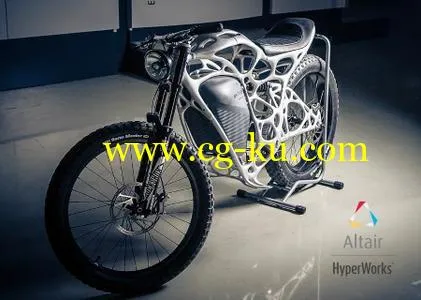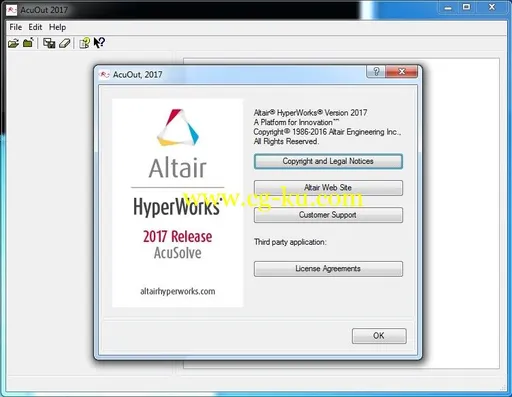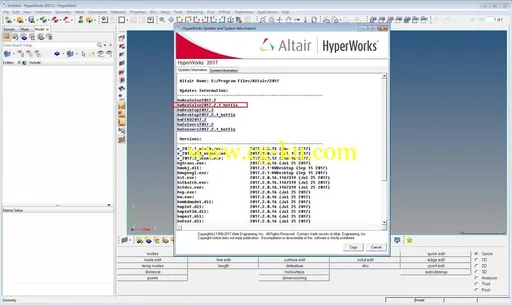Altair HyperWorks AcuSolve 2017.x | 1.0 GbAltair announced a new release of HyperWorks AcuSolve 2017. This release of the software contains an expanded suite of physics, enabling the simulation of transitional turbulent flows, immiscible multiphase flows, and advanced moving mesh capabilitiesThe 2017 release of the AcuSolve product suite brings major advancements in CFD modeling capabilities to HyperWorks users.
The latest release of the software contains an expanded suite of physics, enabling the simulation of transitional turbulent flows, immiscible multiphase flows, and advanced moving mesh capabilities.
In addition to the new physics that are supported with the 2017 release, the software also contains enhancements to existing features, such as an expanded selection of RANS turbulence models, enhancements to the accuracy of non-conformal mesh interfaces, and usability improvements for automatic splitting of nodes.
Turbulence Modeling ImprovementsAcuSolve 2017 delivers major improvements in turbulence modeling capability.
This release expands the range of applications that can be simulated with AcuSolve by introducing new physical models, improving on existing models, and providing more user control over the equations that are solved.
The following features are the highlights of the turbulence modeling improvements in AcuSolve 2017.
- Addition of Two New Turbulence Transition ModelsTurbulent transition plays a major role in the simulation of many engineering applications in which the boundary layer physics dominate the performance of the device.
Examples of these types of applications include flow over airfoils, wings, and turbine blades.
Traditional RANS turbulence models are not capable of accurately predicting the natural transition process that occurs as the laminar boundary layer develops instabilities and becomes turbulent.
In order to properly account for the physics of this process, additional models are necessary.
- Addition of Three New k-epsilon Turbulence ModelsAcuSolve 2017 adds a total of three new k-epsilon based turbulence models to the suite of supported RANS closures.
These models include the realizable k-epsilon model, the RNG k-epsilon model, and the standard k-epsilon model.
All models are fully compatible with AcuSolve’s other features.
- Addition of Menter’s BSL k-omega Turbulence ModelThe BSL k-omega model is a two-equation model developed by Menter around the same time that SST was developed.
The BSL model was the original model that proposed a blending of the k-epsilon and k-omega turbulence models to alleviate the sensitivity of the k-omega model to free stream conditions, while still maintaining the accuracy of k-omega in the boundary layer.
The BSL model (or baseline model) shares many common features with SST, with the largest deviation occurring in the expression used to compute the eddy viscosity.
The BSL model does not include the eddy viscosity limiter that SST does.
Although the SST model is expected to provide superior results on separated flows, the BSL model has been added to AcuSolve to provide an alternative to the standard k-omega model.
- Improvements to SST-DESThe SST-DES model in AcuSolve 2017 has been enhanced to include the Delayed Detached Eddy Simulation (DDES) and Improved Delayed Detached Eddy Simulation (IDDES) variants of the model recently published by Menter.
The original zonal formulation of the model is still supported, but no longer the default.
Starting in AcuSolve 2017, the default type of DDES model for SST is the DDES model.
To recover the behavior of previous releases, the zonal version should be used.
- Simplified Inputs for Turbulent SimulationsThe addition of the new turbulence physics is accompanied by the need to simplify the assignment of inlet boundary values for each of the turbulence model equations.
To accomplish this, the Simple Boundary Condition command has been enhanced to include new methods of assigning inlet boundary values.
The new options expose a set of simplified inputs to users and then automatically compute the inlet boundary values for all active turbulence variables.
The new feature includes a number of automatic options that fully define the turbulence values based on the selection of internal vs.
external flow.
Full control over the turbulence values is still available through the direct input method, which was used in previous releases.
- Exposure of Turbulence Model ConstantsAcuSolve 2017 exposes many new options associated with the suite of turbulence models to users.
To accomplish this, a new command called TURBULENCE_MODEL_PARAMETERS has been introduced.
This command allows control over turbulence model constants, application specific correction terms (i.
e.
rotation/curvature), wall function types, and variations of a given model to be selected (i.
e.
IDDES vs.
DDES).
This new command introduces a much higher level of control over the turbulence models in AcuSolve than in previous releases, and also migrates some settings that were previously exposed.
BETA Feature - Multiphase Flow Simulation CapabilitiesAcuSolve 2017 represents the first release of the solver targeted at the simulation of multiphase flows.
The multiphase flow terminology covers a vast range of applications including bubbly droplet laden flows, slug flows, slurries, fluidized beds, and many more.
AcuSolve’s initial offering within this field is targeted at applications that are typically simulated using a Volume of Fluid (VOF) approach.
These applications include slug flows, free surface flows, and stratified flows.
These applications are characterized by large regions of immiscible fluids in contact with each other.
The interface between the fluids is tracked using an Eulerian interface tracking approach.
This enables the simulation of pouring liquids, free surfaces with large amounts of deformation, bubble entrainment, tank filling/draining applications, tank sloshing applications, and many more.
Improvements to Non-conformal Mesh Interface TechnologyAcuSolve’s non-conformal mesh interface technology has been improved for the 2017 release. This release includes changes to the formulation that improve the accuracy of the solution across the interface as well as a number of other enhancements and fixesImprovements to AcuSolve DocumentationThe 2017 release of AcuSolve delivers an expanded documentation offering to provide tools for successfully learning how to use the software, demonstrating the accuracy of the software, and providing an overview of CFD to new users.
Note: For the full list of changes, updates and resolved issues, please refer to the release notes located in the updates folder of your AcuSolve installation.
About AltairAltair empowers client innovation and decision-making through technology that optimizes the analysis, management and visualization of business and engineering information.
Privately held, with 1,800 employees, Altair has offices throughout North America, South America, Europe and Asia/Pacific.
With a 28-year track record for high-end software for engineering and computing, enterprise analytics solutions, and innovative product design and development, Altair consistently delivers a competitive advantage to customers in a broad range of industries.
Product:Altair HyperWorks AcuSolveVersion:2017.xSupported Architectures:x64Language:englishSystem Requirements:PCSupported Operating Systems:Windows 7even / 8.x / 10Size: 2.4xGb




发布日期: 2017-11-12